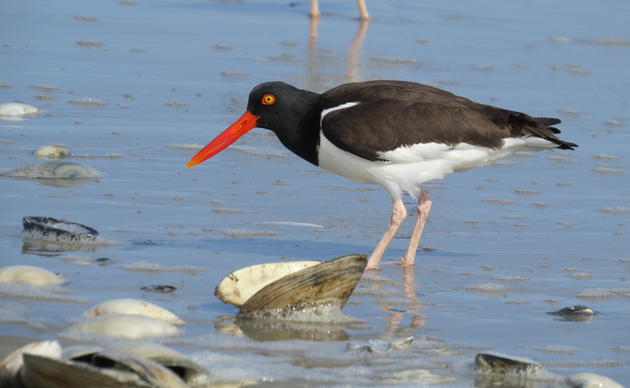September 28, 2018 - A pair of federally-endangered Great Lakes Piping Plovers successfully nested at Sandy Island Beach State Park in Pulaski, NY this summer for the first time in decades. The Great Lakes Piping Plover disappeared from the eastern shores of Lake Ontario in the mid 1980's as their population hit an all-time low in 1986. At that time, the population was solely in Michigan with only 16 nesting pairs.
"State Parks are not only wonderful places for millions of people to explore and have fun, but they also shelter an incredible diversity of plants and animals within their boundaries," State Office of Parks and Recreation and Historic Preservation Commissioner Rose Harvey said. "I'm excited Sandy Island Beach State Park has become a safe haven for this beautiful and rare bird, and we look forward to continuing to work with our partners to protect its habitat."
The adult birds were spotted in mid-May, and monitored closely. Based on predation of the Piping Plover eggs in 2016, a predator exclosure (fence) was erected around the nest to help protect the eggs. All four chicks hatched on June 20th. Staff continued to monitor their progress. Chicks are most vulnerable right after they hatch because they can't fly but need to access the shoreline for food. This makes them fairly defenseless and dependent on their parents to protect them. Following a monitoring program by State Parks and its conservation partners, all four chicks successfully flew on July 29th, before making their way south for the winter.
New York State Office of Parks, Recreation, and Historic Preservation (State Parks), New York State Department of Environmental Conservation (DEC), United States Fish and Wildlife Service (USFWS), New York Natural Heritage Program (NYNHP), State University of New York College of Environmental Science and Forestry (SUNY ESF), Audubon New York, and Onondaga Audubon have collaborated efforts to create a healthy environment for the Piping Plovers to once again thrive on Great Lakes' shores.
State Department of Environmental Conservation Commissioner, Basil Seggos said, "The successful nesting of the Piping Plovers at Sandy Island Beach State Park is excellent news and a testament to the hard work and dedication of the involved agencies toward improving our environment and creating a safe, sustainable habitat for this species. As a partner in this effort, DEC is proud of the successful return of the endangered Piping Plover to the region and will continue to work with our partners to ensure their nesting area remains safe and protected."
"It is incredibly exciting that a pair of federally-endangered Piping Plovers successfully nested on the shores of Lake Ontario in New York. We are very grateful to our partners and volunteers who worked so hard this year to ensure that they were protected," said Ana Paula Tavares, Executive Director of Audubon New York. "Birds serve as environmental indicators and the return and success of this pair is a positive sign that we should all feel proud of."
State Parks has had full time staffing, during breeding and nesting season, on this beach for the last two years to monitor for the birds while also educating the public on how to share the shore with this critically endangered species. State Parks staff Alivia Sheffield, project coordinator, and Shaina Johnson, project technician, were out on the beach monitoring the health and behavior of the four chicks and two adults. On their days off, the beach was monitored by DEC Dune Stewards, State Parks FORCES Stewards, or volunteers. SUNY ESF professor Jonathon Cohen, as well as two of his PhD Candidates, Alison Kocek and Michelle Stantial, monitored and recorded the health of the piping plover family twice a week for the duration of the season.
Sandy Island Beach State Park is a popular spot for recreation for seasonal visitors. The beach is heavily used, but the fenced protected bird nesting area helps to provide a safe space, not only for the Piping Plovers, but other bird species to have a place to rest and forage away from people.
"It was exciting to see the plovers return and successfully nest this year. We appreciate the cooperation of all of the dog owners, boaters, and beach lovers that share the beach and who helped give the birds the space they needed to raise their chicks," said David Stilwell, USFWS, New York Field Office.
To encourage more than one nest in the following years, Staff and partners are working to find the balance between recreation and conservation, making Sandy Island Beach a safe place for birds and people. Although the Piping Plovers have left the beach, this area is an important stop over for other migrating birds and supports several other rare species and habitats. Visitors should be aware of how their actions can impact the species in this unique ecosystem of lakeshore dunes and beach. For more information on piping plovers visit http://guides.nynhp.org/guide.php?id=6850. For information on how to help shorebirds visit http://ny.audubon.org/birds-0birdsways-help/10-ways-help-beach-nesting-birds.
The New York State Office of Parks, Recreation and Historic Preservation oversees more than 250 individual state parks, historic sites, golf courses, boat launches and recreational trails, which are visited by 71 million people annually. For more information on any of these recreation areas, call 518-474-0456 or visit parks.ny.gov connect on Facebook, or follow on Twitter.
###
Contact: Jillian Liner, jliner@audubon.org, 607.254.2437
Protect Vulnerable Shorebirds
Support our Long Island Bird Conservation Program, home to the at-risk American Oystercatcher.




